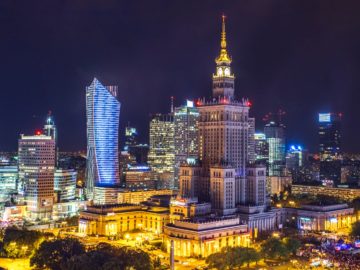Key facts
Poland is a country located in Central Europe. It is bordered by Germany to the west, the Czech Republic and Slovakia to the south, Ukraine and Belarus to the east, and Russian Federation (Kaliningrad Oblast) and Lithuania to the north.
As of 2024, the population of Poland is approximately 38.4 million people. The country has a relatively high population density, with about 124 people per square kilometer. The majority of the population is concentrated in urban areas, with over 60% of the population living in cities and towns. The capital and largest city of Poland is Warsaw, which is home to over 1.7 million people. Other major cities in Poland include Krakow, Lodz, Wroclaw, and Poznan.
In the EF English Competency Index (EF EPI), which assesses the language proficiency of non-native speaking countries, Poland was ranked 16th out of 100 countries in 2021.
The national currency in Poland is Polish złoty (PLN). The złoty (zł) is subdivided into 100 grosz (gr).
Polish
Banknotes
zł10zł20zł50zł100zł200zł500
Polish
Coins
1gr2gr5gr10gr20gr50grzł1zł2zł5
Check with your bank before your trip to find out if there are any fees for using your card abroad. Some banks do not charge fees when you use a foreign ATM or pay in foreign currency, but others may charge a fixed cost for each transaction or allow a limited number of free withdrawals. The travel card provided by Wise.com, Revolut or Monose might be an excellent option to cut down on transaction fees.
Ookla® Speedtest No data available.
ATM Density When compared to the world average, Poland has more ATMs.66.82 ATMs per 100,000 people.The global average is 39.49.
SIM Registration In order to purchase a SIM card in Poland, a passport or ID is required as identification.
Socket types
There are 2 socket types used in Poland. Type C is a popular socket type throughout Europe (except the United Kingdom), Russia, and certain Asian countries.
The sockets’ shapes and voltage differ from country to country and a travel plug adapter may be required. Portable devices, such as phones, notebooks or tablets, usually handle the entire range of voltages used across the world (110-240V).
Public holidays
In the year 2024, Poland will celebrate 13 national public holidays. The next one Assumption Day will take place on August 15.
| Date | Holiday name | |
|---|---|---|
| January 1, 2024 | New Year’s DayNowy Rok | |
| January 6, 2024 | EpiphanyŚwięto Trzech Króli | |
| March 31, 2024Moving holiday | Easter SundayWielkanoc | |
| April 1, 2024Moving holiday | Easter MondayDrugi Dzień Wielkanocy | |
| May 1, 2024 | May DayŚwięto Pracy | |
| May 3, 2024 | Constitution DayŚwięto Narodowe Trzeciego Maja | |
| May 19, 2024Moving holiday | PentecostZielone Świątki | |
| May 30, 2024Moving holiday | Corpus ChristiBoże Ciało | |
| August 15, 2024 | Assumption DayWniebowzięcie Najświętszej Maryi Panny | |
| November 1, 2024 | All Saints’ DayWszystkich Świętych | |
| November 11, 2024 | Independence DayNarodowe Święto Niepodległości | |
| December 25, 2024 | Christmas DayBoże Narodzenie | |
| December 26, 2024 | St. Stephen’s DayDrugi Dzień Bożego Narodzenia |
Sources
- EF English Proficiency Index (EF Education First)
- Speedtest Global Index® (Ookla®)
- Automated teller machines (ATMs) (per 100,000 adults) (The World Bank Group)
- Registration Policies Per Country (Prepaid Data SIM Card Wiki)
Tourism
There are several reasons why tourists visit Poland, including the country’s rich history and cultural heritage, diverse natural landscapes, and vibrant cities. One of the main attractions for tourists in Poland is the country’s numerous UNESCO World Heritage sites, which include the historic center of Kraków, the Wieliczka Salt Mine, the castles of the Teutonic Order in Malbork and Toruń, and the Auschwitz-Birkenau concentration camp. These sites offer visitors a unique opportunity to learn about and experience some of the most significant events and cultural achievements in Poland’s history.
In addition to its cultural heritage, Poland also boasts a number of stunning national parks and nature reserves, such as the Białowieża National Park, the Tatras National Park, and the Pieniny National Park. These parks offer visitors the chance to experience the beauty of Poland’s natural landscapes and to participate in a range of outdoor activities, including hiking, climbing, and skiing.
Finally, Poland’s cities are also popular with tourists. The capital city, Warsaw, is home to a number of cultural and historical attractions, including the Royal Castle, the Old Town, and the Łazienki Palace. Kraków, the former capital of Poland, is also a popular destination, with its stunning architecture and rich cultural history. Other popular cities in Poland include Gdańsk, Wrocław, and Poznań, each of which offers its own unique blend of history, culture, and modern amenities.
What hotel chains are present in Poland?
There are Mariott hotels in 2 cities: Sopot and Warsaw.
The Hilton hotel chain operates in Poland.
The IHG hotel chain operates in Poland.
The Best Western hotel chain operates in Poland.
There are Radisson hotels in 12 cities.
The Accor hotel chain operates in Poland.
Local delicacies and must-try foods and drinks in Poland
- Pierogi:
Pierogi are small dumplings filled with a variety of savory or sweet fillings, such as meat, cheese, potatoes, sauerkraut, or fruit. They are a popular and versatile dish that can be found in many restaurants and street food stalls throughout the country. - Kielbasa:
Kielbasa is a type of sausage that is made from pork, beef, or lamb and seasoned with a variety of spices. It is a popular snack or main course in Poland, and is often served with mustard or horseradish as a condiment. - Bigos:
Bigos is a hearty stew made from a mixture of meats, sauerkraut, and vegetables. It is a popular dish during the colder months and is often served with boiled potatoes or bread. - Żurek:
This is a sour soup made with fermented rye flour and served with sausage, potatoes, and hard-boiled eggs. It is a traditional dish in Poland and is often served during Easter. - Placki ziemniaczane:
Placki ziemniaczane, or potato pancakes, are a popular side dish in Poland. They are made from grated potatoes that are mixed with flour and egg, and are often served with sour cream or applesauce. - Kremówka:
Kremówka is a popular pastry in Poland that consists of a layer of vanilla-flavored custard topped with a layer of whipped cream and dusted with powdered sugar.
When it comes to drinks, Poland is known for its vodka, which is a popular spirit that is often served neat or as part of a cocktail. The country is also home to a variety of local beers, which are popular for their distinctive flavors and high quality.
What fast food chains are present in Poland?
The McDonald’s chain operates in Poland.
The KFC chain operates in Poland.
The Burger King chain operates in Poland.
The Subway chain operates in Poland.
The Domino’s Pizza chain operates in Poland.
The Starbucks chain operates in Poland.
Sources
- Country by National Dish (Samson Daniel)
Weather
What is the climate like in Poland?
In general, the western and northern regions of Poland have a cooler, more maritime climate, with temperatures ranging from -5 to 15 degrees Celsius in the winter and 15 to 25 degrees Celsius in the summer. The eastern and southern regions of the country have a warmer, more continental climate, with temperatures ranging from -10 to 5 degrees Celsius in the winter and 20 to 30 degrees Celsius in the summer.
Rainfall is distributed fairly evenly throughout the year, with the heaviest rainfall occurring in the summer months. The country also experiences occasional extreme weather events, such as storms, flooding, and heatwaves.
Overall, the climate in Poland is quite diverse, with different regions experiencing different weather patterns and temperatures. It is always a good idea to check the weather forecast and dress appropriately when traveling to different parts of the country.
When is the best time to visit Poland?
If you prefer to avoid the crowds and enjoy more reasonable prices, you may want to consider visiting Poland during the shoulder seasons of April, October, and November. These months offer a mix of pleasant weather and lower tourist numbers, making them a good time to visit if you want to experience the country in a more relaxed and authentic way.
What is the weather like in Warsaw?
Weather data for Warsaw (capital city) by Open-Meteo.com
Transport
How easy is it to get around Poland by train?
PKP also operates a number of international trains that connect Poland to other countries in Europe, including Germany, Czech Republic, Slovakia, Ukraine, and Belarus.
How easy is it to get around Poland by car?
There are also a number of national and regional roads in Poland, which provide additional connectivity between the different parts of the country.
Railways There are passenger trains , and some of them are high-speed trains.
Subway Systems The subway system is available in Warsaw.
Sources
- List of high-speed railway lines (Wikipedia)
- List of metro systems (Wikipedia)
- Left- and right-hand traffic (Wikipedia)
- The Global Enabling Trade Report 2016: Road connectivity (World Economic Forum)
Safety
Emergency phones in Poland
Sources
- Poland Travel Advisory (United States: Department of State)
- Travel Advice for Poland (United Kingdom: The Foreign, Commonwealth & Development Office)
- Mortality caused by road traffic injury (The World Bank Group)
- Corruption & Economic Crime (United Nations Office on Drugs and Crime)
Smoking & Alcohol
Smoking ban Smoking is prohibited in all public places excluding entertainment and restaurants. Local limitations may apply in some areas.
Cananbis legality Recreational usage is prohibited, but medical use is legal.
You are not entitled to a duty-free allowance for tobacco or alcohol if you are under the age of 17.
Alcohol allowance
Travellers from EU countries:
- 90L of still wine (60L of sparkling wine)
- 110L of beer
- 10L of alcoholic beverages stronger than 22%
- 20L of fortified or sparkling wine or other liqueurs up to 22%.
Travellers from non-EU countries:
- 4L of wine
- 16L of beer
- 1L of spirits over 22% volume or 2L of alcoholic beverages less than 22% volume
Tobacco allowance
Travellers from EU countries:
- 800 cigarettes or 400 cigarillos or 200 cigars or 1kg of tobacco
Travellers from non-EU countries:
Your tobacco allowance is determined on your form of transportation.
If you are travelling by air or sea:
- 200 cigarettes or 100 cigarillos or 50 cigars or 250g of tobacco
If you are NOT travelling by air or sea:
- 40 cigarettes or 20 cigarillos or 10 cigars or 50g of tobacco
Sources
- Custom Service info (brochure in PDF)
- Alcohol, tobacco, cash and excise duties (europa.eu)
- Personal imports (European Commission)
- List of smoking bans (Wikipedia)
- Legality of cannabis (Wikipedia)



